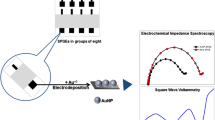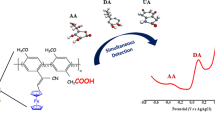Abstract
In this work, an electrochemical method for sensitive determination of creatinine has been reported based on its reaction with 2-nitrobenzaldehyde and using differential pulse voltammetry technique. A plausible mechanism of the reaction has been proposed and successful application of this method for creatinine detection in a real sample (human urine) has also been demonstrated. The mechanism is indicative of the formation of multiple electroactive species in the process. The linear range of detection being 1–25 mM, with LOD of 0.50 mM and an excellent R2 value of 0.99, was suitable enough for the detection of creatinine in human urine. Interference studies of urea, uric acid, glucose, ascorbic acid and dopamine were done and found to be within the acceptable limit. All the components except uric acid showed an interference of less than 3.2%, while uric acid showed maximum interference of 8.4%. Its robustness, high selectivity, good sensitivity, and low detection limit have projected it as a promising new tool for a point-of-care testing device.
Graphic Abstract










Similar content being viewed by others
References
Rao H, Lu Z, Ge H, Liu X, Chen B, Zou P, Wang X, He H, Zeng X, Wang Y (2017) Electrochemical creatinine sensor based on a glassy carbon electrode modified with a molecularly imprinted polymer and a Ni@ polyaniline nanocomposite. Microchim Acta 184:261–269. https://doi.org/10.1007/s00604-016-1998-x
Sittiwong J, Unob F (2016) Paper-based platform for urinary creatinine detection. Anal Sci 32:639–643. https://doi.org/10.2116/analsci.32.639
Income K, Ratnarathorn N, Khamchaiyo N, Srisuvo C, Ruckthong L, Dungchai W (2019) Disposable nonenzymatic uric acid and creatinine sensors using pad coupled with screen-printed reduced graphene oxide-gold nanocomposites. Int J Anal Chem 2019:3457247. https://doi.org/10.1155/2019/3457247
Jaffe M (1886) Ueber den Niederschlang, welchen Pikrinsaoure in nomalen Harn erzeugt und uber eine neue Reaktion des Kreatinins. Z Physiol Chem 10:391–400. https://doi.org/10.1515/bchm1.1886.10.5.391
de Oliveira Moreira OB, de Souza JCQ, Candido JMB, do Nascimento MP, Chellini PR, de Lemos LM, de Oliveira MAL (2023) Determination of creatinine in urine and blood serum human samples by CZE-UV using on-column internal standard injection. Talanta 258:124465. https://doi.org/10.1016/j.talanta.2023.124465
Liotta E, Gottardo R, Bonizzato L, Pascali JP, Bertaso A, Tagliaro F (2009) Rapid and direct determination of creatinine in urine using capillary zone electrophoresis. Clin Chim Acta 409:52–55. https://doi.org/10.1016/j.cca.2009.08.015
Karn-orachai K, Ngamaroonchote A (2021) Role of polyelectrolyte multilayers over gold film for selective creatinine detection using Raman spectroscopy. Appl Surf Sci 546:149092. https://doi.org/10.1016/j.apsusc.2021.149092
Yang F, Wen P, Li G, Zhang Z, Ge C, Chen L (2021) High-performance surface-enhanced Raman spectroscopy chip integrated with a micro-optical system for the rapid detection of creatinine in serum. Biomed Opt Express 12:4795–4806. https://doi.org/10.1364/BOE.434053
Gangopadhyay D, Sharma P, Nandi R, Das M, Ghosh S, Singh RK (2016) In vitro concentration dependent detection of creatinine: a surface enhanced Raman scattering and fluorescence study. RSC Adv 6:112562–112567. https://doi.org/10.1039/C6RA22886K
Hanif S, John P, Gao W, Saqib M, Qi L, Xu G (2016) Chemiluminescence of creatinine/H2O2/Co2+ and its application for selective creatinine detection. Biosens Bioelectron 75:347–351. https://doi.org/10.1016/j.bios.2015.08.053
Yen TA, Dahal KS, Lavine B, Hassan Z, Gamagedara S (2018) Development and validation of high performance liquid chromatographic method for determination of gentisic acid and related renal cell carcinoma biomarkers in urine. Microchem J 137:85–89. https://doi.org/10.1016/j.microc.2017.09.024
Zuo Y, Wang C, Zhou J, Sachdeva A, Ruelos VC (2008) Simultaneous determination of creatinine and uric acid in human urine by high-performance liquid chromatography. Anal Sci 24:1589–1592. https://doi.org/10.2116/analsci.24.1589
Tsikas D, Wolf A, Mitschke A, Gutzki FM, Will W, Bader M (2010) GC–MS determination of creatinine in human biological fluids as pentafluorobenzyl derivative in clinical studies and biomonitoring: inter-laboratory comparison in urine with Jaffé, HPLC and enzymatic assays. J Chromatogr B 878:2582–2592. https://doi.org/10.1016/j.jchromb.2010.04.025
Lewińska I, Speichert M, Granica M, Tymecki Ł (2021) Colorimetric point-of-care paper-based sensors for urinary creatinine with smartphone readout. Sens Actuators B 340:129915. https://doi.org/10.1016/j.snb.2021.129915
Liang L, Xiong Y, Duan Y, Zuo W, Liu L, Ye F, Zhao S (2022) Colorimetric detection of creatinine based on specifically modulating the peroxidase-mimicking activity of Cu-Fenton system. Biosens Bioelectron 206:114121. https://doi.org/10.1016/j.bios.2022.114121
He Y, Zhang X, Yu H (2015) Gold nanoparticles-based colorimetric and visual creatinine assay. Microchim Acta 182:2037–2043. https://doi.org/10.1007/s00604-015-1546-0
Menéndez G, Amor-Gutiérrez O, García AC, Funes-Menéndez M, Prado C, Miguel D, Rodríguez-González P, González-Gago A, Alonso JIG (2023) Development and evaluation of an electrochemical biosensor for creatinine quantification in a drop of whole human blood. Clin Chim Acta 543:117300. https://doi.org/10.1016/j.cca.2023.117300
Li J, Li Z, Dou Y, Su J, Shi J, Zhou Y, Wang L, Song S, Fan C (2021) A nano-integrated microfluidic biochip for enzyme-based point-of-care detection of creatinine. Chem Commun 57:4726–4729. https://doi.org/10.1039/D1CC00825K
Caliskan S, Yildirim E, Anakok DA, Cete S (2022) Design of a new biosensor platform for creatinine determination. J Solid State Electrochem 26:549–557. https://doi.org/10.1007/s10008-021-05107-5
Pandey PC, Mishra AP (2004) Novel potentiometric sensing of creatinine. Sens Actuators B 99:230–235. https://doi.org/10.1016/j.snb.2003.11.016
Dasgupta P, Kumar V, Krishnaswamy PR, Bhat N (2020) Biochemical assay for serum creatinine detection through a 1-methylhydantoin and cobalt complex. RSC Adv 10:39092–39101. https://doi.org/10.1039/D0RA06470J
Chen JC, Kumar AS, Chung HH, Chien SH, Kuo MC, Zen JM (2006) An enzymeless electrochemical sensor for the selective determination of creatinine in human urine. Sens Actuators B 115:473–480. https://doi.org/10.1016/j.snb.2005.10.015
Kumar RKR, Shaikh MO, Kumar A, Liu CH, Chuang CH (2023) Zwitterion-Functionalized Cuprous Oxide Nanoparticles for highly specific and Enzymeless Electrochemical Creatinine Biosensing in Human serum. ACS Appl Nano Mater 6:2083–2094. https://doi.org/10.1021/acsanm.2c05020
Teekayupak K, Aumnate C, Lomae A, Preechakasedkit P, Henry CS, Chailapakul O, Ruecha N (2023) Portable smartphone integrated 3D-Printed electrochemical sensor for nonenzymatic determination of creatinine in human urine. Talanta 254:124131. https://doi.org/10.1016/j.talanta.2022.124131
Ponnaiah SK, Periakaruppan P (2020) Carbon dots doped tungstic anhydride on graphene oxide nanopanels: a new picomolar-range creatinine selective enzymeless electrochemical sensor. Mater Sci Eng: C 113:111010. https://doi.org/10.1016/j.msec.2020.111010
Kumar V, Hebbar S, Kalam R, Panwar S, Prasad S, Srikanta SS, Krishnaswamy PR, Bhat N (2017) Creatinine-iron complex and its use in electrochemical measurement of urine creatinine. IEEE Sens J 18:830–836. https://doi.org/10.1109/JSEN.2017.2777913
Raveendran J, Resmi PE, Ramachandran T, Nair BG, Babu TS (2017) Fabrication of a disposable non-enzymatic electrochemical creatinine sensor. Sens Actuators B 243:589–595. https://doi.org/10.1016/j.snb.2016.11.158
Singh P, Mandal S, Roy D, Chanda N (2021) Facile detection of blood creatinine using binary copper–iron oxide and rGO-based nanocomposite on 3D printed ag-electrode under POC settings. ACS Biomater Sci Eng 7:3446–3458. https://doi.org/10.1021/acsbiomaterials.1c00484
SATO N, TAKEDA K, NAKAMURA N (2021) Development of a copper-electrodeposited gold electrode for an Amperometric Creatinine Sensor to Detect Creatinine in urine without pretreatment. Electrochemistry 89:313–316. https://doi.org/10.5796/electrochemistry.21-00016
Fava EL, do Prado TM, Garcia-Filho A, Silva TA, Cincotto FH, de Moraes FC, Faria RC, Fatibello-Filho O (2020) Non-enzymatic electrochemical determination of creatinine using a novel screen-printed microcell. Talanta 207:120277. https://doi.org/10.1016/j.talanta.2019.120277
Fekry AM, Abdel-Gawad SA, Tammam RH, Zayed MA (2020) An electrochemical sensor for creatinine based on carbon nanotubes/folic acid/silver nanoparticles modified electrode. Measurement 163:107958. https://doi.org/10.1016/j.measurement.2020.107958
Boobphahom S, Ruecha N, Rodthongkum N, Chailapakul O, Remcho VT (2019) A copper oxide-ionic liquid/reduced graphene oxide composite sensor enabled by digital dispensing: non-enzymatic paper-based microfluidic determination of creatinine in human blood serum. Anal Chim Acta 1083:110–118. https://doi.org/10.1016/j.aca.2019.07.029
Zhybak M, Beni V, Vagin MY, Dempsey E, Turner AP, Korpan Y (2016) Creatinine and urea biosensors based on a novel ammonium ion-selective copper-polyaniline nano-composite. Biosens Bioelectron 77:505–511. https://doi.org/10.1016/j.bios.2015.10.009
Viswanath KB, Devasenathipathy R, Wang SF, Vasantha VS (2017) A new route for the enzymeless trace level detection of creatinine based on reduced graphene oxide/silver nanocomposite biosensor. Electroanalysis 29:559–565. https://doi.org/10.1002/elan.201600425
Riegert A (1939) Un nouveau microdosage colorimetrique de la creatininc, son application au plasma et au serum. Compt rend Soc biol 132:535
Van Pilsum JF, Martin RP, Kito E, Hess J (1956) Determination of creatine, creatinine, arginine, guanidinoacetic acid, guanidine, and methylguanidine in biological fluids. J Biol Chem 222:225–236. https://doi.org/10.1016/s0021-9258(19)50788-8
Jones JD, Giovannetti S (1971) Charcoal-catalyzed oxidation of creatinine to methylguanidine. Biochem Med 5:281–284. https://doi.org/10.1016/0006-2944(71)90030-5
Nakai T, Ohta T, Obinata Y, Kojima M (1978) Air Oxidation of Creatine (or Creatinine) in strongly acidic solution: formation of Methylguanidine. Agric Biol Chem 42:891–892. https://doi.org/10.1080/00021369.1978.10863080
Manissorn J, Fong-Ngern K, Peerapen P, Thongboonkerd V (2017) Systematic evaluation for effects of urine pH on calcium oxalate crystallization, crystal-cell adhesion and internalization into renal tubular cells. Sci Rep 7:1798. https://doi.org/10.1038/s41598-017-01953-4
Liu L, Mo H, Wei S, Raftery D (2012) Quantitative analysis of urea in human urine and serum by 1H nuclear magnetic resonance. Analyst 137:595–600. https://doi.org/10.1039/C2AN15780B
Sechi D, Greer B, Johnson J, Hashemi N (2013) Three-dimensional paper-based microfluidic device for assays of protein and glucose in urine. Anal Chem 85:10733–10737. https://doi.org/10.1021/ac4014868
Harris LJ, Ray SN, Ward A (1933) The excretion of vitamin C in human urine and its dependence on the dietary intake. Biochem J 27:2011–2015. https://doi.org/10.1042%2Fbj0272011
Dalirirad S, Steckl AJ (2020) Lateral flow assay using aptamer-based sensing for on-site detection of dopamine in urine. Anal Biochem 596:113637. https://doi.org/10.1016/j.ab.2020.113637
Iwata H, Nishio S, Yokoyama M, Matsumoto A, Takeuchi M (1989) Solubility of uric acid and supersaturation of monosodium urate: why is uric acid so highly soluble in urine? J Urol 142:1095–1098. https://doi.org/10.1016/S0022-5347(17)39003-1
Chauhan N, Kumar A, Pundir CS (2014) Construction of an uricase nanoparticles modified au electrode for amperometric determination of uric acid. Appl Biochem Biotechnol 174:1683–1694. https://doi.org/10.1007/s12010-014-1097-6
Exner O, Böhm S (2005) Protonated nitro group: structure, energy and conjugation. Org Biomol Chem 3:1838–1843. https://doi.org/10.1039/B502152A
Nakamura K, Ohira C, Yamamoto H, Pfleiderer W, Ienaga K (1990) Creatones A and B. Revision of the structure for the product of oxidation of creatinine and creatine. Bull Chem Soc Jpn 63:1540–1542. https://doi.org/10.1246/bcsj.63.1540
Acknowledgements
Mr. Nayab Hussain (DST-INSPIRE fellow, IF180956) would like to thank DST-INSPIRE for funding.
Author information
Authors and Affiliations
Contributions
NH conceived the original idea, carried out the experiments, prepared the figures and wrote the first draft of the manuscript. Both NH and PP carried out the analyses and interpretations. PP supervised the work, provided critical feedback and helped to shape the final manuscript.
Corresponding author
Ethics declarations
Conflict of interest
There are no conflicts of interest to declare.
Additional information
Publisher’s Note
Springer Nature remains neutral with regard to jurisdictional claims in published maps and institutional affiliations.
Supplementary Information
Below is the link to the electronic supplementary material.
Rights and permissions
Springer Nature or its licensor (e.g. a society or other partner) holds exclusive rights to this article under a publishing agreement with the author(s) or other rightsholder(s); author self-archiving of the accepted manuscript version of this article is solely governed by the terms of such publishing agreement and applicable law.
About this article
Cite this article
Hussain, N., Puzari, P. A novel method for electrochemical determination of creatinine in human urine based on its reaction with 2-nitrobenzaldehyde using a glassy carbon electrode. J Appl Electrochem 54, 175–187 (2024). https://doi.org/10.1007/s10800-023-01938-4
Received:
Accepted:
Published:
Issue Date:
DOI: https://doi.org/10.1007/s10800-023-01938-4




